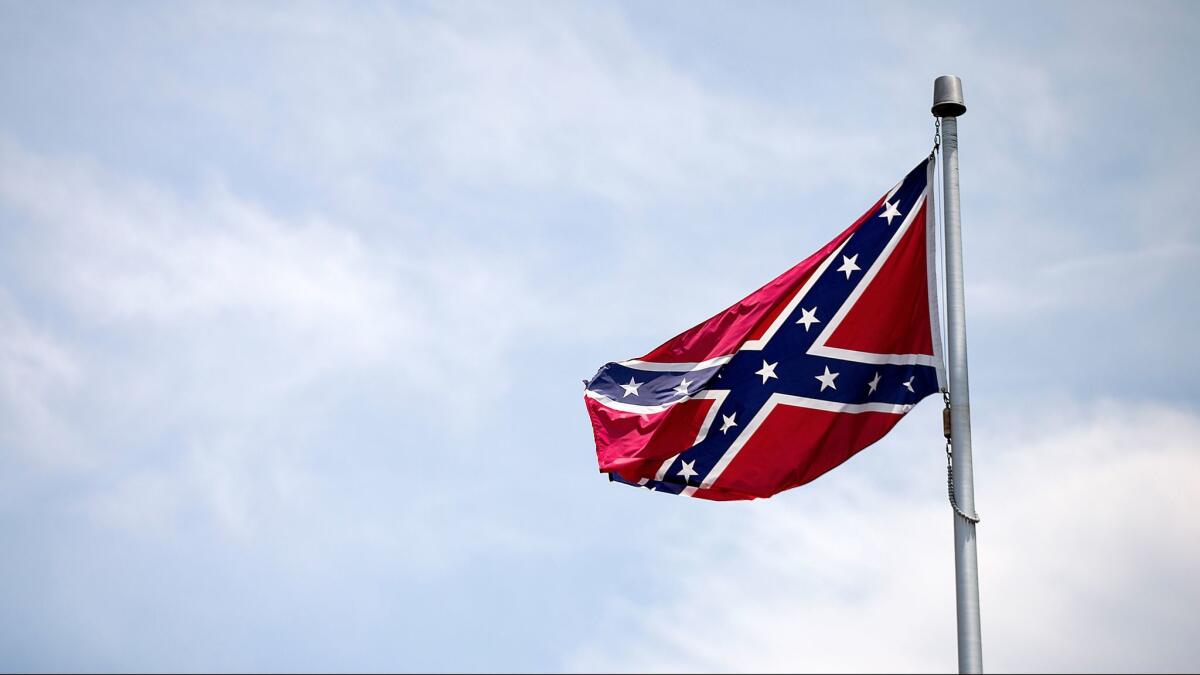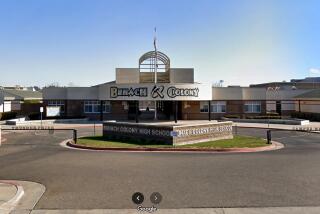Op-Ed: My California high school had a Confederate mascot

When I tell friends my high school mascot was a Confederate soldier, I’m usually asked to repeat myself. Didn’t I say I was from California? I did — I am. I’m from the Antelope Valley, a group of towns in the Mojave Desert about 60 miles north of Los Angeles. That’s where, in 2005, I graduated from Quartz Hill High School, home of the Rebels.
Because California has been and remains a symbol of progress in this country, it’s easy to forget the state’s complicated history with slavery. In the state’s first decade, pro-slavery inhabitants of rural Southern California, along with Spanish-speaking Californios, proposed the formation of a new, slave-owning state split off from the North. In 1859, Gov. John B. Weller signed a measure that would have made this a reality and sent it to Washington for approval. If it weren’t for the outbreak of the Civil War, the proposal might have passed.
Although California allied itself with the Union during the Civil War, many in Southern California sympathized with the South, and some even left the state to fight for the Confederacy.
A century later, in the same year the Civil Rights Act was signed into law, Quartz Hill High School was established amid arduous legal battles with the local government, which wanted to place the school in a different part of town. The school’s founders fought to keep Quartz Hill on their desired west side, and succeeded. This legal tenacity was the source of their nickname, the Rebels, which they lent to the school.
The Confederate theme — with a stars-and-bars-waving mascot named Jubilation T. Cornpone, later replaced by the more generic Johnny Reb — emerged from this fairly anodyne history. And so Johnny Reb marched on, waving his Confederate flag at football games and pep rallies and on the glossy covers of yearbooks.
Any reluctance to remove statues and flags has to do with pride. The question is, who gets to be proud, and what do we want to be proud of?
For a few decades, anyway. Slowly the Confederate theme began to wilt. By the late 1980s, the annual homecoming tradition of Slave Day — in which students “auctioned off” other students to raise money for clubs — was put to rest. As for the mascot, despite the overwhelmingly white community’s support to keep Johnny Reb exactly as he was, pressure from the NAACP put an end to his Confederate flags in 1995.
One woman interviewed at the time explained her anguish at the decision: “I have heritage from both sides of the Civil War. My Confederate family fought very hard for what they believed in. I am proud of them for that. Again, I just don’t think that it is easy here to say what is most fair to the community.” She wasn’t — and isn’t — alone in that thinking. As of this writing, the high school’s alumni page on Facebook continues to harvest complaints and lamentations over the mascot change.
For Johnny Reb, however, all was not lost: Stripped of his name, flag and weapons, and given a Revolutionary-era tricorn hat to obscure his politics, the Rebel soldier remained the mascot. Despite these updates, my classmates and I never mistook which side of which war our uniformed man was fighting for. He was a Rebel, after all, not a Patriot — the more appropriate name for a soldier in the American Revolution. Only in researching the school years later did I even realize that the mascot was no longer officially associated with the Confederacy. Young people can hear all too clearly the dog-whistles their politically motivated adult counterparts deny.
I’m sorry to say the Rebel was, in some ways, an entirely appropriate mascot. We were white — abnormally white, even for the standards of Antelope Valley. When I graduated in 2005, just 8% of students at QHHS were black, while I was among the 70% that were white. By contrast, Antelope Valley High — the local public school without the esteemed International Baccalaureate program — had more black students than white: 33% to 25%. At Quartz Hill, equipped with our superior collegiate training and emboldened by our rebellious mascot, a common joke was that the A.V. in A.V. High School stood for African Village.
That kids in high school make racist jokes is not news, but in retrospect it seems to me that our surrounding iconography not only permitted but also encouraged our behavior.
Even if the Rebel wasn’t technically a Confederate by the time I reached high school, the word “rebel” itself is a racially loaded term. In our cultural imagination, rebels are almost exclusively young white men. (Think of Luke Skywalker, and the backlash when one of the main characters in “The Force Awakens” was revealed to be black.) Young black men fighting against oppressive systems — say, police brutality — are rarely afforded the same label. More commonly they’re referred to as thugs, criminals, delinquents and opportunists.
What does it mean to live in a culture that’s simultaneously disdainful of disrespect and yet extremely proud of rebelliousness? Where the line between the two is so thick and darkly drawn?
Any reluctance to remove statues and flags has to do with pride. The question is, who gets to be proud, and what do we want to be proud of?
Confederate history is not tethered to the South. The stars and bars held high by a white terrorist in a photograph taken before he massacred nine black churchgoers in Charleston, S.C., is the same flag hoisted across the hateful shadows of this country, from Virginia to Washington, from New England to California. In the age of newly emboldened white supremacists, it should be painfully obvious that no longer is the Confederate statue a symbol of Southern pride; it is a symbol of white pride.
Banning state agencies from displaying the Confederate flag, as Gov. Jerry Brown has done in California — stowing it rightfully in museums and in history books — will not end racism. But it can suggest to young people that our government, despite its worst elements, despite its leader, is in the business of dismantling the scaffoldings of hate, that we reject the heinous and boundless ideology of white supremacy. Any call to compromise — to change hats, as it were — is absurd, ineffective, and dishonest. What’s needed is complete removal. Removing these shameful icons will help, a little, to put our slave days behind us.
Chris McCormick is an assistant professor at Minnesota State University, Mankato, and the author of “Desert Boys.”
Follow the Opinion section on Twitter @latimesopinion or Facebook
More to Read
A cure for the common opinion
Get thought-provoking perspectives with our weekly newsletter.
You may occasionally receive promotional content from the Los Angeles Times.










